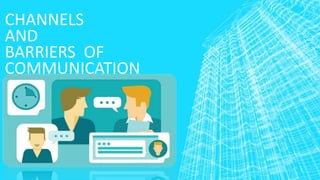
Channels & barriers of communication
- 2. WHAT IS COMMUNICATION ? It is a process of exchanging- Information Ideas Thoughts Feelings Emotions Through – Speech Signals Writing Behavior
- 3. CHANNELS OF COMMUNICATION Communication is the process of sharing of information. It moves from one person to the other. It travels along a prescribed path. This path is called network or channel. Network is a system of intersecting lines and channels is the path through which a message travels. They can be divided into the following categories.
- 4. FORMAL AND INFORMAL CHANNELS OF COMMUNICATION There are precisely these two forms of communications in every organization. Formal communications are those which are bound with all rules and regulations, Ex. Order, Notice , etc. Informal communication includes the non official or un- regulated communications, Ex. Rumors, un-verified information. The both exist simultaneously in an organization.
- 5. FORMAL CHANNELS OF COMMUNICATION Organizational communication flows along a prescribed network which is known as “formal channel of communication”. Each organization creates a network through which information travels in designated directions. The employees strictly follow the network to transfer the messages. The networks can be divided into the following categories. :- ▪ Chain network ▪ Y network ▪ Wheel network ▪ Circle network ▪ Star network
- 6. The chain network: Under this network, the message flows in a direct vertical line along the scalar chain of command. The Y network: In this network, the person at the fork Of “Y” is the central person. s/he Communicates with three person.
- 7. The Wheel network Under it, a number of subordinates reports to one Superior. It is called wheel because all communi- cations pass through the center person similar to the hub of wheel. The circle network In case of circle network, the message moves in a circle. Under each person can communicate with two others located on both of his sides.
- 8. The star network In this network, every member has freedom To communicate with other member(s), Regardless of rank or status. It connects all The employees of the organization. Every Member can directly communicate with Other member without mediator. The advantages and disadvantages and Formal channels of communication
- 9. THE INFORMAL CHANNELS OF COMMUNICATIONS The network or channels of information communication is known as grapevine. It represent the unofficial channel of communication. Which is created and controlled by people themselves rather than the other. It is a means of passing on information unofficially.
- 10. THE GRAPEVINE CHAIN Informal communication is also known as grapevine communication. Grapevine carrier information from an individual or group to other individual or group. It does not follow any definite route grapevine can disseminate information in the following ways : Single strand chain Gossip chain Probability chain Cluster chain
- 11. The single strand chain In this network , the information travels from one individual to the other, regardless of rank or status, who transmits it to the next. The process of communication is very much linear. The gossip chain In this network, a number of person are involved. All of them talk to one another informally, one of them remains in center of the system and plays a key role In the dissesnimaton of information. The person transit the information to other person.
- 12. The probability chain In this network, an individual acts as a primary source of message. s/he randomly selects the people around him/her to communicate a message. The persons are not chosen deliberately rather by the matter of chance. The cluster chain In this network, the source of message selects a number of person to communicate the message. The secondary persons then pass on the message to pre-selected number of person.
- 15. INTRODUCTION Barriers means ‘obstacle’, ‘hurdle’ or ‘hindrance’, which comes in the way of free flow. There are various obstacles that act as barriers in the way of the transmission of message. They cause confusion, misunderstanding and conflicts. So, the situations or conditions that make the communication difficult, complex and frustrating are called “barriers of communication” they can be divided into the following categories. ▪ Physical barriers ▪ Phycological barriers ▪ Semantic barriers ▪ Cultural barriers ▪ Organizational barriers ▪ Mechanical barriers
- 16. Physical barriers The physical conditions that come in the way of effective communication are called physical barriers. The conditions can be related to environment, position of the sender and receiver, or so… Some of theme are. a) Noise b) Distance c) Time d) Information overload. Physiological barriers Communication involves listening/reading , encoding , decoding and interpretation of message. It depends on the physical state or both the communicator and the receiver . Some of the physiological barriers are.
- 17. 1) Emotions 2) Inattention 3) Premature evaluation 4) Poor retention 5) Distrust 6) Lack of background knowledge 7) Lack of interest. Semantic barriers Semantic is the study of meaning of a word, phrase or sentence. Oral or written communication is based on words, but words can be used in deferent ways. It can create misunderstanding or confusion between the sender and receiver, this is known as semantic barriers of communication. Some of are. a) Poor expression b) Technical words c) Faulty translation.
- 18. Cultural barriers Cultural is the behavioral features of particular group. Every group has its own characteristics, such as speech writing style, language , festivals etc. these difference often come up as communication barriers, cultural barriers can be classified as. a) Intercultural difference b) Religion c) Ethnocentrism. Organizational barriers Communication is essential within and outside an organization. There are certain hindrance which affect the free flow of communication. They are called ‘organizational barriers’. Some of theme are. a)Structure
- 19. b) Rules and regulations c) Distortion. Mechanical barriers Mechanical equipment's play an important role in the process of communication. something these gadgets act as a barriers to communication. The barriers can be: a) Breakdown b) Improper choice
- 20. THANK YOU Prepared by : SUNIL & TEAM
